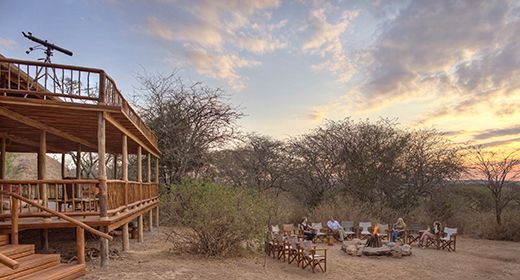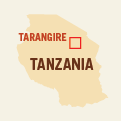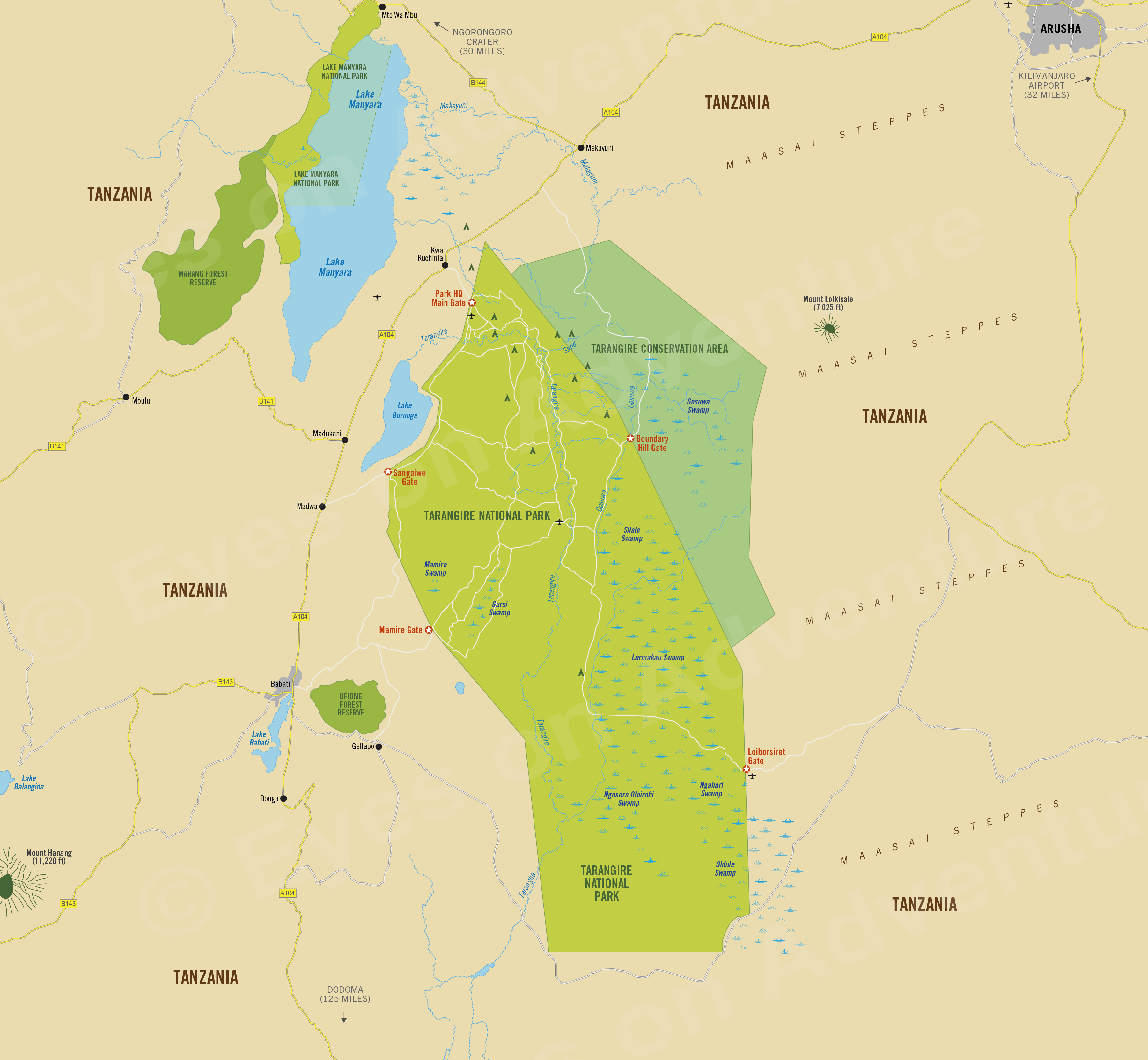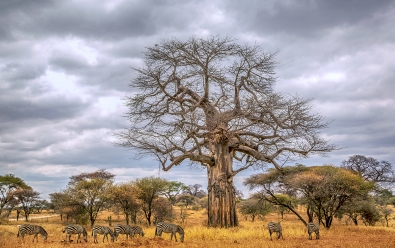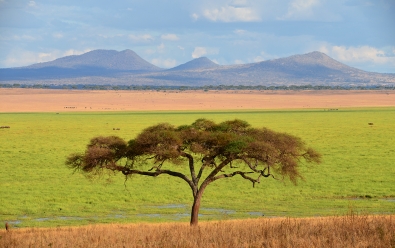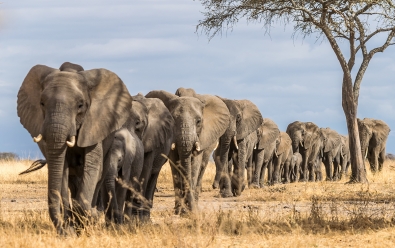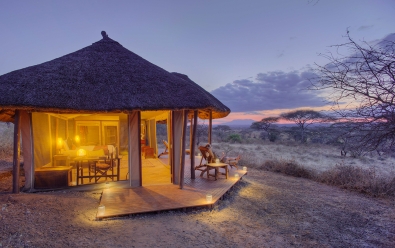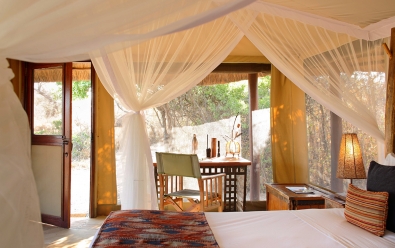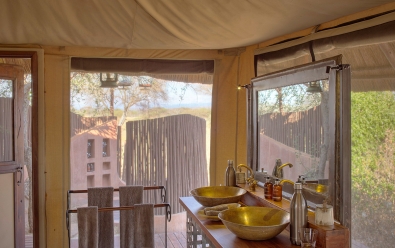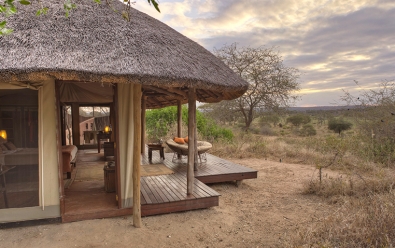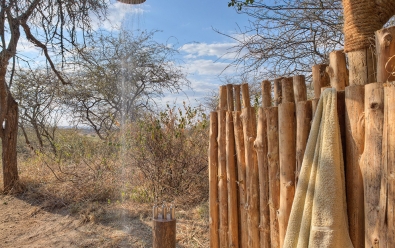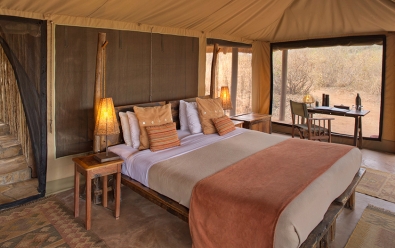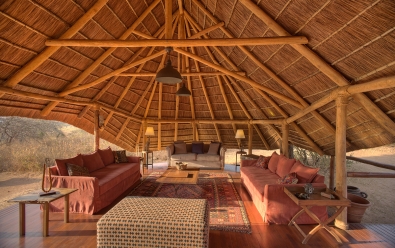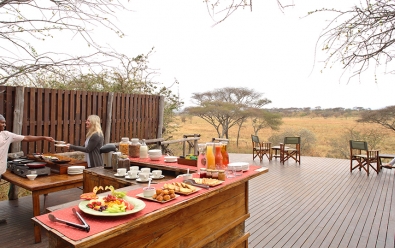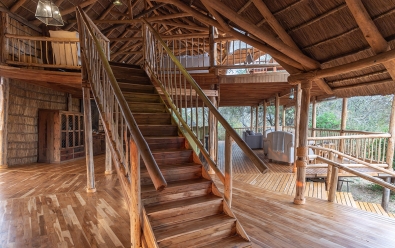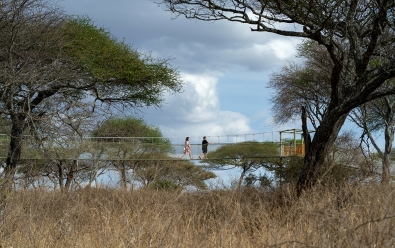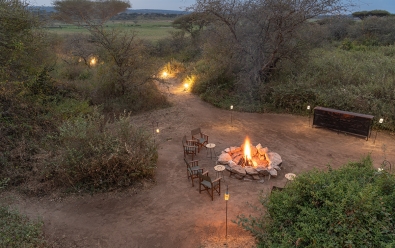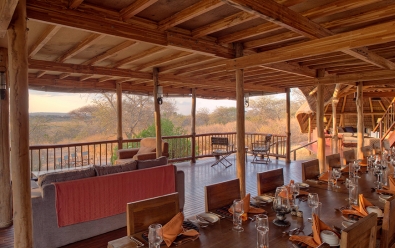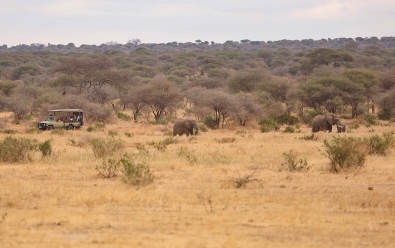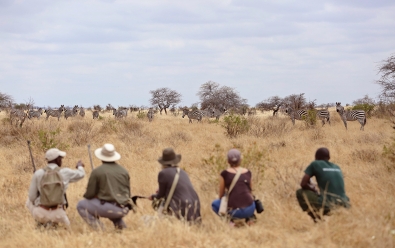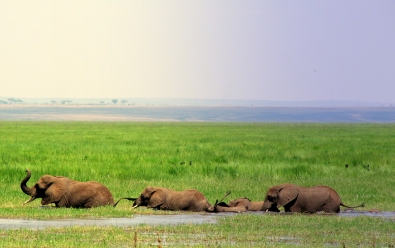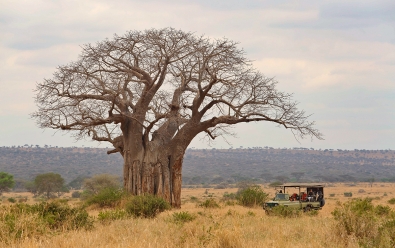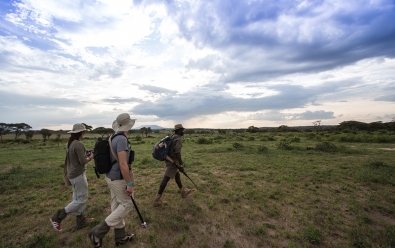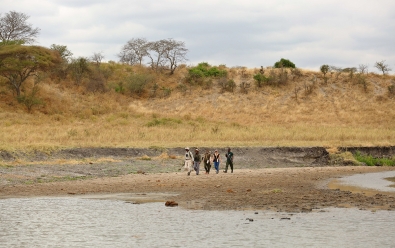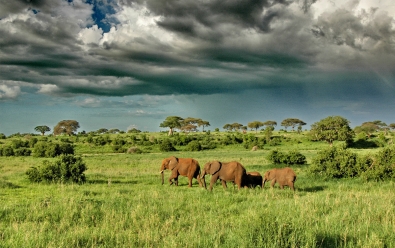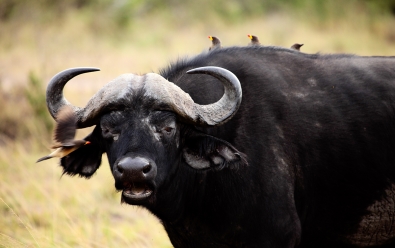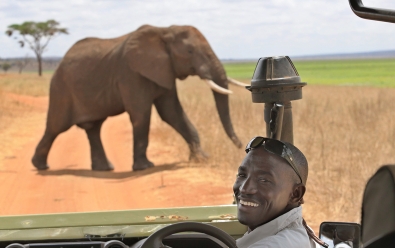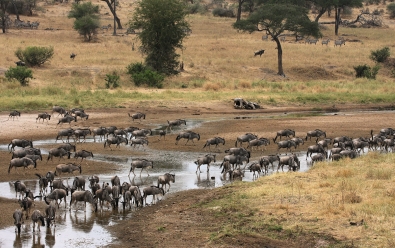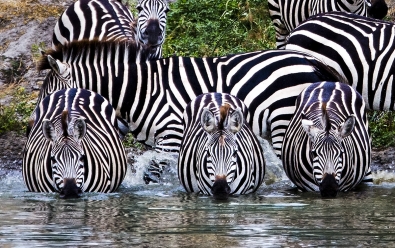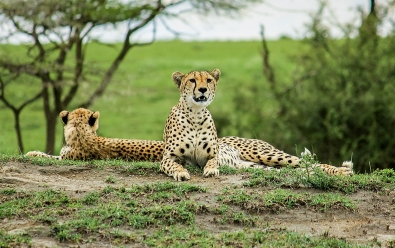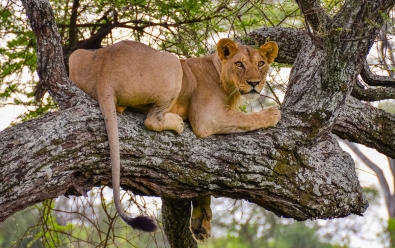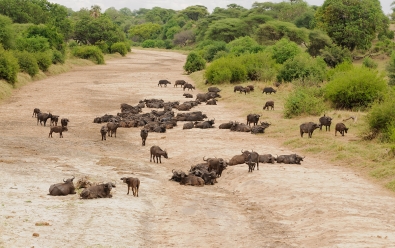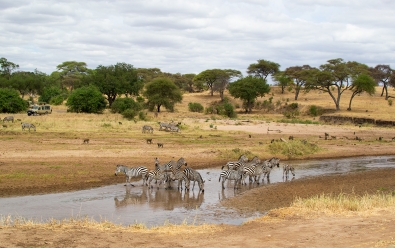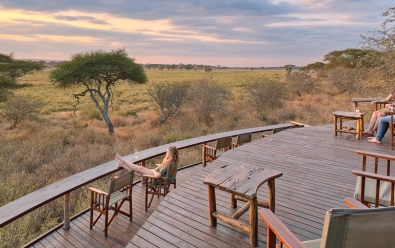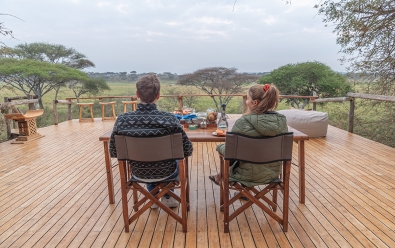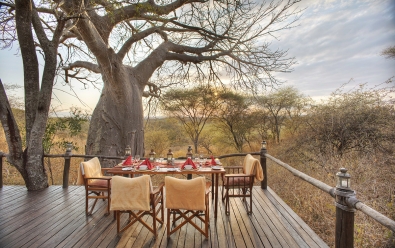Oliver's Camp
Highlights
- Excellent wildlife viewing, particularly during the dry season
- Located along the Tarangire River with lovely scenery
- The seasonal Tarangire Migration between July and October
- Day and night game drives, great walking safaris, ballooning
Location
- Tarangire National Park
- Northern Tanzania
Oliver's is a classic safari camp, reminiscent of early-day, East African adventures, located in a remote site along the Tarangire River.
Oliver's Camp is the furthest south of the safari accommodations in Tarangire, giving guests an opportunity to explore the wildlife-rich swamps located in the central and southern portions of the national park.
The camp's site along the Tarangire River, which is the life-source for the park's wildlife, means that wildlife viewing can often occur from the veranda of one's deck or while enjoying a midday swim in the pool.
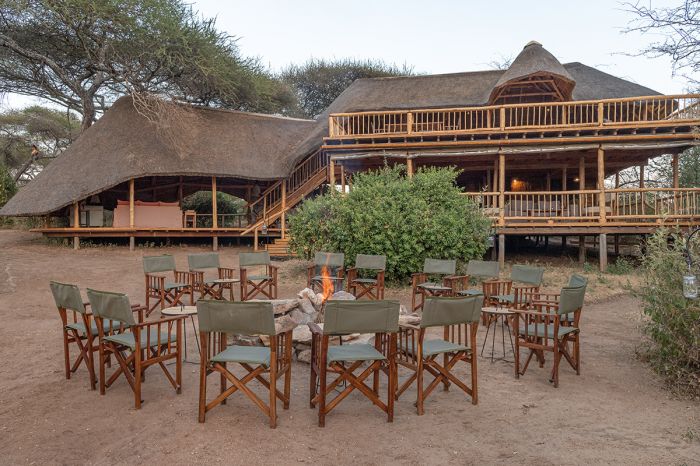
The lodge and campfire area at Oliver's Main Camp.
Activities at Oliver's focus on game drives, both daytime and after dark, as well as some of the best walking safaris in Africa. Full-day game drives with a packed picnic lunch allow access to almost any section of the park. Other activities include hot-air ballooning and an evening spent with the Tarangire-Manyara Lion Research Team.
The camp offers 15 tented guest suites divided into two separate, but connected (by radio walkway) satellite camps, one with 10 suites (Oliver's Main Camp) and the other with 5 suites (Little Oliver's). The smaller camp is ideal for a group traveling together.
Two of the guest suites in the main camp have two bedrooms and are designed for families. Children aged 5 years and above are welcome.
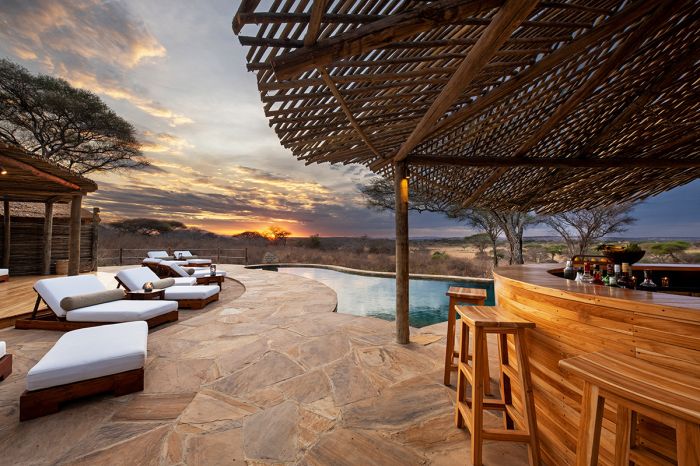
The swimming pool, sundeck, and pool bar at Oliver's Camp.
The main guest areas at both camps include a guest lounge with a bar, a dining room, and a campfire area. There is a swimming pool located between the two camps and overlooking the Tarangire River.
Tarangire is an oft-overlooked destination for safaris in northern Tanzania, but its deserves consideration, particularly during the dry, winter months between July and October, when Tarangire is absolutely pumping with wildlife, especially elephants.
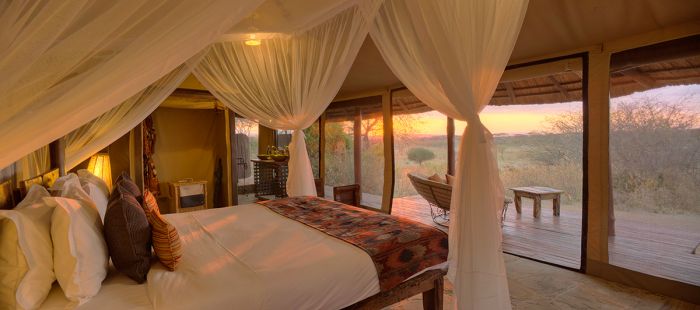
Guest suite at Oliver's Camp.
About Tarangire
Tarangire is comprised of the Tarangire National Park and the adjoining Tarangire Conservation Area (TCA), which together occupy nearly 1 250 square miles (3 250 sq kms) of wilderness in Africa's Rift Valley. Tarangire is part of Tanzania's northern safari circuit, which also includes the Serengeti, Ngorongoro, and Lake Manyara regions.
Tarangire's core protected area is based around the Tarangire River, which flows north through the 1 010-square-mile (2 616-sq-km) Tarangire National Park before emptying into Lake Burunge, which lies just west of the northern section of the park. An additional 226 square miles (585 sq kms) is protected as the Tarangire Conservation Area (TCA). To the east are the Maasai Steppes, covering roughly 1 900 square miles (5 000 sq kms) of unprotected, but mostly uninhabited land.
The Tarangire region is drier than the Serengeti, with dense Acacia scrubland and woodlands, especially in the north and along the rivers. Tarangire's baobab trees are a notable feature in the northern area of the national park and TCA. Seasonal swamps dominate the southern half of the national park.
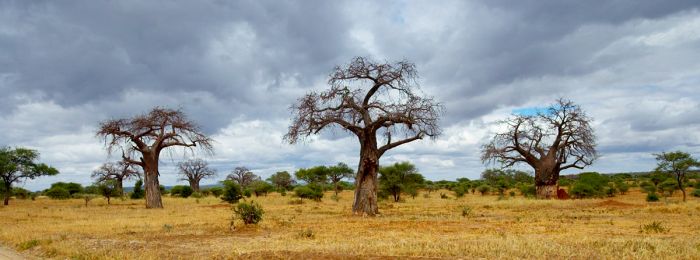
Baobab trees dominating this landscape in Tarangire National Park.
Tarangire National Park
Tarangire National Park was established in 1970 to protect the diversity of wildlife, birds, and habitats along the perennial Tarangire River. The northern portion of the park is the most developed and offers year-round safaris. The bend of the Tarangire River and its east-west portion is particularly good for wildlife.
The northern section is dominated by hilly grasslands, Acacia woodlands, patches of riparian woodland along the Tarangire River, and numerous baobab trees. The road network in the north is well established, with tracks running on either side of the Tarangire River.
Moving south, the park gradually becomes defined by seasonal marshes, which are a haven for birds. Most of the roads in this central portion of the park are passible all year, though some become difficult during the rainy season. The far south of the park is extremely remote and is only reachable during the dry season, but even then, it is seldom explored.
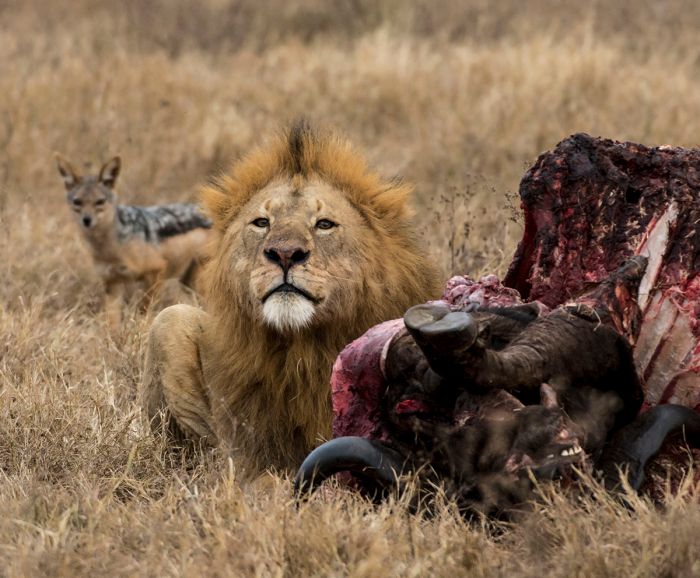
A male lion guards a buffalo kill as a black-backed jackal looks on - Tarangire National Park.
The Tarangire River, which flows north through the entirety of the national park, is the life source for the entire region. Even during the peak of the dry season (August-October), when most of the region has little to no water, the mostly dry Tarangire riverbed still supports life-sustaining pools of water.
Wildlife from across the region congregate at the Tarangire River for its water, including large numbers of elephant, wildebeest, and zebra. The animals spend the dry months close to the river, providing excellent game viewing. Once the short rains begin in November, the animals disperse into the surrounding areas.
Tarangire's swamps are located in the central and southern reaches of the park and offer some of the country's richest breeding grounds for birds during the rainy season (between November and May). During the dry season (June-October), the swamps recede, but the remaining marshland offers superb game viewing, especially for buffalo, lion, and elephant.
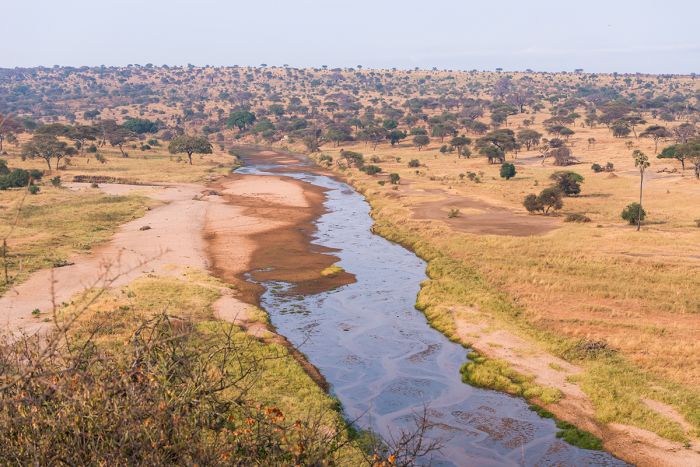
The Tarangire River provides water to the park's abundant wildlife.
TARANGIRE CONSERVATION AREA (TCA)
Bordering Tarangire National Park in the northeast is the Tarangire Conservation Area (TCA). The TCA was established in the late 1990s as Tanzania's first community-managed wildlife area.
The TCA is comprised of multiple Wildlife Management Areas (WMAs) that are owned and managed by separate groups of Maasai communities. Some of the WMAs offer eco-tourism as a source of revenue for their land, while others are used for cattle grazing or mixed-use purposes.
The Tarangire River's primary watershed is found in the TCA and these seasonal "sand" rivers, provide pools of water during the dry season for an abundance of wildlife. Game viewing in the TCA can even surpass that in the national park.
The TCA is not subject to national park regulations, so night drives and walking safaris are an option at the safari camps located here.
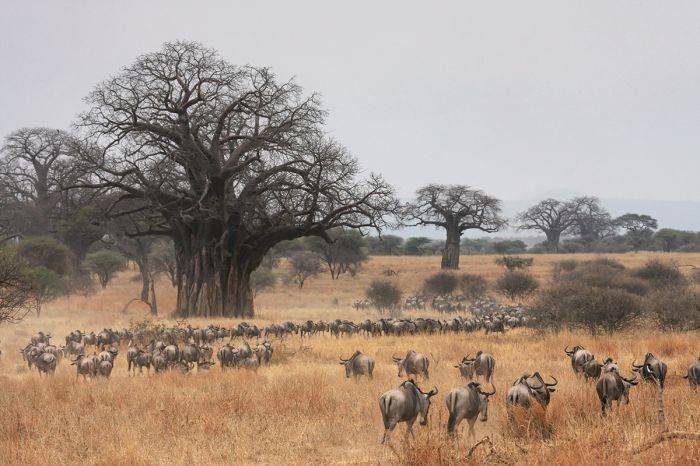
Tarangire's migration is present during the dry season.
WILDLIFE & MIGRATION
Tarangire is home to a little-known wildlife migration, which is much smaller than the great Serengeti-Masai Mara migration. The annual migration at Tarangire consists of some 25 000 wildebeest, 30 000 Burchell's zebra, 2 500 elephant, and modest numbers of fringe-eared oryx. The concentration of mammals in Tarangire during the dry season months (July-October) is second only to the Serengeti and Ngorongoro Crater in Tanzania.
The migrating animals begin to arrive to the Tarangire region at the onset of the dry season (usually in late July) to take advantage of the remaining water and waterholes along the Tarangire River bed and its watershed tributaries. The migrating wildlife remain in Tarangire until the rains arrive, usually sometime in November. When the short rains in November begin in earnest, the zebras and wildebeests depart Tarangire, heading north to Lake Manyara or east into the Maasai Steppes.
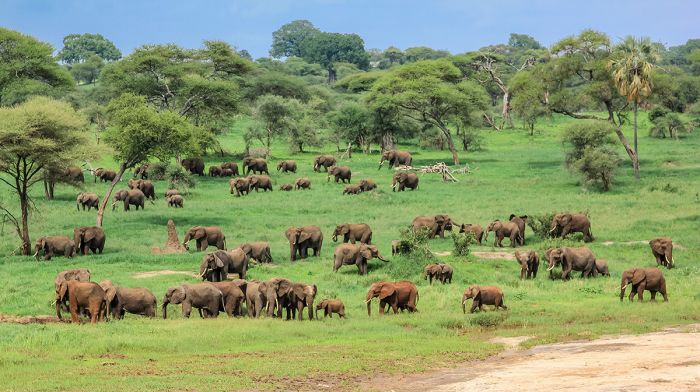
A large congregation of elephants in the Tarangire Conservation Area.
By the time the long rains arrive in April/May, the migrating animals are spread out over a huge area roughly ten times the size of Tarangire National Park. Some elephants migrate all the way into Kilimanjaro and Amboseli National Park. When the long rains are over and the plains begin to dry up (usually between mid-May and early June), the animals start to head again towards Tarangire, where by August, they have arrived in huge numbers again.
Many of Tarangire's animals are year-round residents, including lion, leopard, buffalo, giraffe, zebra, eland, waterbuck, bushbuck, Thomson's gazelle, Coke's hartebeest, impala, warthog, hippo, black-backed jackal, ostrich, olive baboon, vervet monkey, and significant numbers of elephant. Cheetah are seen in Tarangire on occasion but are uncommon, as are spotted hyenas. Less common mammals include the odd-looking gerenuk antelope, with its extra long neck, lesser kudu, and striped hyena.
Birding in Tarangire is superb, with over 500 species recorded. The Tarangire River and the swamps are especially productive birding areas. West of the park's boundary is Lake Burunge, which attracts a variety of waterbirds all year and large numbers of flamingos during the dry season.
ROOMS INCLUDES & EXCLUDES CHILDREN FACILITIES ACTIVITIES
Accommodation
15 guest accommodations in total comprised of two separate satellite camps situated next to each other and connected by a raised walkway.
Oliver's Main Camp
10 guest accommodations in total comprising:
- 8 twin-bedded wood-and-canvas suites, each with a double bed that is convertible to a twin-bedded setup.
- 2 family-sized, wood-and-canvas suites, consisting of two bedrooms, one with a double bed (convertible to twins) and one with two single beds. The bedrooms each have their own en-suite facilities. A doorway connects the two bedrooms.
Little Oliver's
5 guest accommodations in total comprising:
- 5 twin-bedded wood-and-canvas suites, each with a double bed that is convertible to a twin-bedded setup. This section of the overall camp is ideal for a group of up to 10 adults traveling together.
Three of the suites can accommodate an additional single bed for a child under 16 years.
All suites include plumbed, en-suite facilities with a double-basin vanity, indoor shower, outdoor shower, and toilet. The suites are connected to the main camp area by footpaths on the ground.
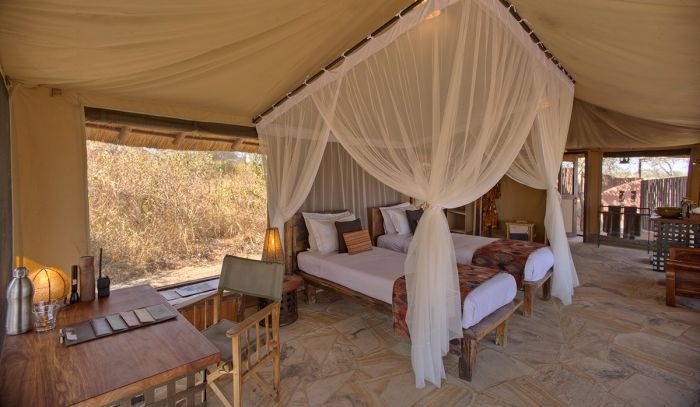
Guest suite interior at Oliver's Camp.
The main lodge area and guest suites are located amidst an open wooded area, close to and facing the Tarangire River.
The tented accommodations in both satellite camps are constructed on a wooden deck with wrap-around outdoor verandas. The walls and ceilings of the suites are canvas and supported by wooden beams. An outer roof of thatching supported by wooden beams covers the suite.
Other items and features in the guest suites include:
- Outdoor deck / veranda with tale and seating.
- Writing desk and chair.
- Wardrobe for clothes storage.
- Floor fan.
- Safe.
- Mosquito netting over the beds.
- 24-hour power (provided using a combination of solar and generator) for lighting and charging electronics.
- WiFi available in the guest suites and main guest areas.
- Mobile phone signal available, but limited.
Oliver's Camp (including both satellite sections) can accommodate a maximum of 37 guests in total: 2 persons in each of the 13 standard suites, 3 additional children in the 3 suites convertible to a triple, and 4 persons in each of the 2 family suites.
Includes & Excludes
Includes:
- All meals and house drinks, including wines, local brand spirits and beers, teas, and coffees.
- Safari experiences (twice-daily or full-day game drives, night drives, bush walks, and birding) accompanied by an experienced guide.
- Sundowner drinks and snacks.
- Laundry services are provided on a daily basis (weather permitting, items will be returned on the same day). Laundry is dried by the sun and on most days any laundry placed out in the morning will be returned by the evening.
- Wi-Fi access (throughout the entire camp).
- Kuro Airstrip transfers.
- Tourism Levy & VAT.
Excludes:
- Champagne, cognacs, fine wines, premium brand spirits, and cigars.
- Hot-air ballooning (best to book in advance).
- Tarangire Lion Research Initiative experience.
- Purchases from the Gift Shop.
- Any applicable wildlife fee, park fee, reserve fee, concession fee, other land-use fee.
Single Supplement
A single supplement may apply for any room booked by a single traveler; please ask us for pricing.
Children
Children aged 5 years and older are accommodated at Oliver's Camp:
- 2 family suites and 3 standard suites available as a triple.
- Ask us about reduced rates for children sharing with adults or children 12-17 in their own suite.
- The minimum age for children on bush walks is 12 years and at the discretion of the guide.
- Children's menu available.
- Children under 5 years are allowed only if the camp is booked exclusively.
Game drives with children:
- During high and peak seasons, families (less than 5 persons) with children aged 0-12 years must pre-book a private vehicle.
- During low and peak seasons, families (less than 5 persons) with children aged 0-12 years will receive a private vehicle FOC subject to availability. Vehicle must be pre-booked.
- Year-round, families with children aged 0-12 years will receive a private vehicle FOC for every 5 persons in the family. This is subject to vehicle availability and must be booked in advance.
Facilities
The main guest area and suites are located along the eastern side of the Tarangire River, a short distance from the riverbank.
The camp is divided into two distinct satellite camps, connected by a raise walkway and with shared access to the swimming pool and deck, which is centrally located.
Oliver's Main Camp comprises a two-level, open-air, wooden structure that includes a dining area, lounge, and bar. The roof is constructed using thatching. There are viewing decks on both levels that can also be used for dining.
The slightly smaller main guest area at Little Oliver's comprises a single-level, wood-and-thatch-covered structure atop concrete flooring. Both satellite camps have a campfire area in front of the main guest structures.
Main guest area facilities include:
- Two satellite camps (Oliver's Main and Little Oliver's), each with separate main guest areas and opearety as separate, but connected camps. Little Oliver's is ideal for a group of up to 10 guests traveling together.
- Oliver's Main has 10 guest suites (including 2 family suites). Little Oliver's has 5 guest suites.
- Each camp has its own lounge, dining area, and kitchen.
- Centrally-located, shared swimming pool and deck.
- Dining is typically communal, but private dining is available on request.
- Gift Shop.
- Complimentary Wi-Fi access.
- Mineral water is provided in the main camp areas and in the guest suites.
- The camp is powered by a combination of solar energy and diesel generator.
Activities
Activities included in the rate:
- Morning and afternoon/evening game drives in semi-open 4x4 vehicles.
- Shorter drives after dark are also possible to see some of the park's nocturnal animals.
- Guided bush walks. Children must generally be 12 years of age (or given clearance at the discretion of the guide).
- Full-day game drives with a packed picnic.
- Sundowners.
- Birding.
- Child-friendly activities.
- All game drive vehicles fitted with inverters for battery charging on game drives.
Optional activities at additional cost:
- Private activities are on offer (subject to vehicle availability, which needs to be booked in advance).
- Hot-air ballooning (please book in advance).
- Tarangire Lion Research Initiative experience. Evening activity allowing guests to meet the research team and learn about their work to conserve the Tarangire/Manyara lion population. Pre-booking required.
Example of a typical day:
- Early morning wake-up call. Morning wake-up and activity times vary according to the seasons, activities on offer, and wildlife sightings.
- Light breakfast before departing on the morning activity or food packed for an earlier departure.
- Return to the camp for a meal and rest period (full-day outings mean lunch is packed).
- Meet for afternoon tea and snacks (savory and sweet choices) before departing on the activity.
- Return to camp - freshen up or meet for drinks, followed by dinner.
- Enjoy a nightcap and/or discussion at the bar or around the campfire before retiring.
Great Good Fair Poor
- Jan
- Feb
- Mar
- Apr
- May
- Jun
- Jul
- Aug
- Sep
- Oct
- Nov
- Dec
General Tips
The best time to visit the Tarangire region is during the dry season, between June and October and into early November. The dry season is also the time when the relatively lesser known Tarangire migration (as opposed to the well-known Serengeti-Masai Mara migration) arrives to the region, greatly increasing the abundance of wildlife that is present (read more about this below).
As with most of northern Tanzania, most of Tarangire rainfall occurs between November and May and there are two somewhat distinct rain seasons, the 'short' rains and the 'long' rains (read more below).
Tarangire Treetops is closed from 01-March thru 15-May. Minimum 2-night stay.
RAIN SEASON
Short Rains
The short rains occur for about one month sometime during November and December (the exact time varied somewhat year to year). This period is called the 'short' rains because the duration of an individual rain event is typically brief and it is rare to have an all-day rain event. Most rain falls as an afternoon shower, while mornings are typically overcast or clear.
Long Rains
The long rains occur between March and May, with April being the wettest month of the year. During this tome, rain should be expected almost every day and the showers can last for hours at a time, although all-day rain is not typical. The roads in Tarangire become muddy and very difficult in places, which can hamper game drives. Cloudy skies are typical and temperatures can be chilly at times.
The period between the short and long rains (January and February) also receives rain, but many days are clear and the amount and duration of the rain events is unpredictable, with some afternoon showers and the odd long and heavy rainfall event.
TEMPERATURES
The temperatures in the Tarangire do not have great variation throughout the year, as the region lies between 3 and 5 degrees south of the equator. In general, daytime temperatures are comfortably warm and overnights and early mornings are comfortable to somewhat chilly. Bring a fleece and rain jacket regardless of the timing of your visit.
Dry Season
The dry season (June to October) is sunny and warm most days and rarely hot. Rare rain showers can occur but are unlikely. From June thru October, the afternoon temperature averages 78-80°F (26-27°C), but some days can be warmer. Evenings and early mornings temperatures are often chilly, averaging 55-58°F (13-14°C).
Rainy Season
The rainy season is November through May (read more above) and the temperatures are slightly higher than in the dry season, remaining fairly static throughout the season. Daytime temperatures average 80-84°F (27-29°C) and nighttime and early morning temperatures are chilly, but slightly warmer than the dry season, averaging 59-62°F (15-17°C).
The Tarangire Migration
Contrasted with the much more well-known 'Great Migration' that occurs to the north in the Serengeti and Masai Mara grasslands, the Tarangire Migration is much smaller in terms of animal numbers and includes a greater variation os species.
The Serengeti migration is undertaken by only two species of herbivore: the blue wildebeest and the plains zebra. The number of animals in this great migration numbers around 1.5 million individuals. This migration occurs in an endlessly clockwise movement across the vast grasslands covering the Greater Serengeti-Mara of Tanzania and Kenya, as the animals constantly seek out fresh grazing.
The Tarangire Migration occurs when a variety of animals, including elephant, blue wildebeest, Grevy's zebra, eland, and fringe-eared oryx, arrive to the Tarangire region at the onset of the long dry season to survive on the region's only available remaining water at this time, which is the Tarangire River. Although the river does not actually flow above ground during this time, there are pools of water along its course and this is enough for thousands of animals to sustain themselves as they await the rains that will arrive in November.




